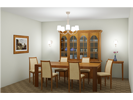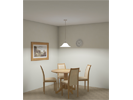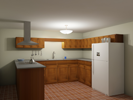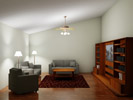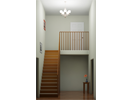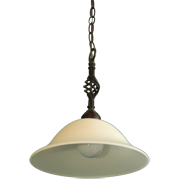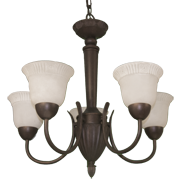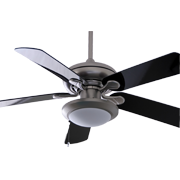
Suspended Fixtures
Suspended lights include downlight pendants, uplight pendants, ceiling fans, and chandeliers. These hang from the ceiling by a rod, cord, or chain. Suspended fixtures provide ambient and/or task lighting. Suspended fixtures are available in many sizes and shapes, and can accommodate a variety of bulbs including incandescent, CFL, LED, and linear fluorescent lamps (tubes).
Suspended fixtures are a good choice for rooms with high ceilings. Bulbs in suspended fixtures should be shielded from view to reduce glare, so carefully adjust the height of the fixture. Some suspended fixtures have cords or chains that allow for repositioning.
Suspended downlights, also called pendants, direct most of the light downward. The lighting distribution patterns vary with the size and shape of the fixture. To shield bulbs from view, fixtures that are used for ambient lighting typically have a translucent shade and those used for table lighting have an opaque metal or fabric shade. In most cases, suspended downlights used for task lighting should be supplemented with other fixtures that provide ambient lighting. If the fixture is intended to provide a significant amount of the ambient light, avoid fixtures that have dark or opaque shades or diffusers.
For lighting a dining table, place fixtures above the eye level of any seated person. The lowest point of the fixture should hang at least 30 inches above the table. Chandeliers often use dimmers to create various light levels and save energy.
Uplights aim light toward the ceiling and upper portion of the walls so that these surfaces serve as reflectors, creating soft, shadowless indirect light. Consider introducing a downlighting element to the design by using uplights made of translucent materials. For best reflectance and efficiency, paint the ceiling white or a light color, using matte paint. For balconies or stair landings, locate the suspended uplight so that the bulb will not be visible when the fixture is viewed from above. Suspend the fixture at least 18 inches below the ceiling because a fixture mounted closer to the ceiling could create a "hot spot," an area of extreme brightness.
Ceiling fans are best used in rooms with high ceilings. Choose products that have the fan and fixture switched separately.
Cautions
- To reduce glare, suspended uplight fixtures should be shielded and/or installed above eye level.
- When using ceiling fans, avoid locating other fixtures in positions that would direct light through the blades because an unpleasant stroboscopic effect may occur.
- When selecting bulbs for downlights or other fixtures in which the bulbs can be seen, make sure the appearance of the bulbs is acceptable. For fixtures in which the bulb should not be seen, make sure the bulbs are small enough that they do not protrude outside of the diffuser, or use covered bulbs.
Example Patterns
